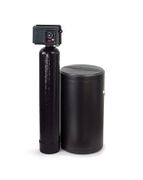Since 2004 Glass Water Systems has been a leader in Economical Water Treatment. Residential, Commercial, and Industrial Water Treatment Products. BEST PRICES GAURANTEED
FLECK 2510 3/4 2 CF NITRATE FILTER SYSTEMS
Product Description
12x48 resin tank
2.0 cubic feet of resin
16,400 ppm Nitrate removal
8 gpm service flow rate
4 gpm backwash flow rate
Floor Space Required is 28x15x56
Shipping Weight is 160 lbs
Purolite® A520E Macroporous Strong Base Anion Exchange Resin
Purolite A520E is a macroporous strong base anion resin which is specially designed for the removal of nitrates from water for potable processes. The macroporous matrix and special ion exchange group functionality imparts ideal nitrate selectivity to Purolite A520E making this resin particularly suitable for nitrate removal even when moderate to high concentrations of sulphate are present. Hence this resin gives superior performance in nitrate removal applications when compared with standard exchange resins. A requirement of the nitrate removal process is to produce potable water meeting the quality standard defined by the European Economic Community in the Directive No. 80/778 of July 1980. This directive limits the nitrates to a maximum admissable concentration (M.A.C.) of 50 mg NO3/l. The U.S.A. drinking water regulations limit nitrates to 45 mg NO3/l.
Sodium chloride is generally preferred for regeneration for reasons of cost and efficiency. When available sea water can be used quite effectively. The use of softened water for make up of regenerant and rinse is often recommended to avoid the precipitation of calcium carbonate in and around the Purolite A-520E (or any other resin used in this application). Although the precipitation is not particularly detrimental in the short term, the long term effects may include increased resin attrition and leakage of nitrates.
Purolite A-520E is processed to insure that it meets the requirements for use in the treatment of potable water. On installation it is recommended that the resin be regenerated with two bed volumes of 6% NaCl followed by a rinse of four bed volumes of potable water, prior to use.
The pressure drop or headloss across a properly classified bed of ion exchange resin depends on the particle size distribution, bed depth, and void volume of the exchange material as well as on the viscosity (and hence on the temperature) of the influent solution. Factors affecting any of these parameters, for example the presence of particulate matter filtered out by the bed, abnormal compressability of the resin, or the incomplete classification of the bed will have an adverse effect and result in an increased headloss. Depending on the quality of the influent water, the application and the design of the plant, service flow rates may vary from 10 - 40 bed volumes/hour (1 - 5 gpm/ft3).
Purolite® A520E Macroporous Strong Base Anion Exchange Resin
Purolite A520E is a macroporous strong base anion resin which is specially designed for the removal of nitrates from water for potable processes. The macroporous matrix and special ion exchange group functionality imparts ideal nitrate selectivity to Purolite A520E making this resin particularly suitable for nitrate removal even when moderate to high concentrations of sulphate are present. Hence this resin gives superior performance in nitrate removal applications when compared with standard exchange resins. A requirement of the nitrate removal process is to produce potable water meeting the quality standard defined by the European Economic Community in the Directive No. 80/778 of July 1980. This directive limits the nitrates to a maximum admissable concentration (M.A.C.) of 50 mg NO3/l. The U.S.A. drinking water regulations limit nitrates to 45 mg NO3/l.
Sodium chloride is generally preferred for regeneration for reasons of cost and efficiency. When available sea water can be used quite effectively. The use of softened water for make up of regenerant and rinse is often recommended to avoid the precipitation of calcium carbonate in and around the Purolite A-520E (or any other resin used in this application). Although the precipitation is not particularly detrimental in the short term, the long term effects may include increased resin attrition and leakage of nitrates.
Purolite A-520E is processed to insure that it meets the requirements for use in the treatment of potable water. On installation it is recommended that the resin be regenerated with two bed volumes of 6% NaCl followed by a rinse of four bed volumes of potable water, prior to use.
The pressure drop or headloss across a properly classified bed of ion exchange resin depends on the particle size distribution, bed depth, and void volume of the exchange material as well as on the viscosity (and hence on the temperature) of the influent solution. Factors affecting any of these parameters, for example the presence of particulate matter filtered out by the bed, abnormal compressability of the resin, or the incomplete classification of the bed will have an adverse effect and result in an increased headloss. Depending on the quality of the influent water, the application and the design of the plant, service flow rates may vary from 10 - 40 bed volumes/hour (1 - 5 gpm/ft3).




